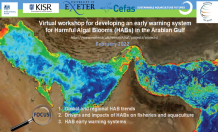Articles

In the image above chlorophyll concentrations are captured by the MODIS Aqua sensor (NASA), representing a bloom of the harmful alga Margalefidinium (Cochlodinium) spp. (in Anderson et al., 2017; Courtesy of R. Kudela and NASA).
Dates confirmed for "Virtual workshop for developing an early warning system for Harmful Algal Blooms (HABs) in the Arabian Gulf"
The virtual workshop will take place on 22 and 23 February 2022 to explore existing knowledge and data on Harmful Algal Blooms (HAB) and impacts on fisheries and finfish aquaculture in the Arabian Gulf. The workshop is being sponsored by the UK and Kuwait Governments and is endorsed by GlobalHAB.
Click here for HABs Workshop programme
Global aquaculture production from finfish, shellfish and seaweed is projected to grow by 32% from 2018-2030, helping to ensure food security and alleviate pressures on wild stocks from overharvesting and climate change. In the Arabian Gulf finfish aquaculture alone is projected to grow by over 7% between 2018 and 20241. However, the growth of the aquaculture industry is threatened by HABs, which are being observed increasingly at aquaculture sites around the globe, with some HAB species causing mass fish mortalities. Numerous mass fish kills have been recorded in the Arabian Gulf and Sea of Oman and many of these coincide with blooms of ichthyotoxic HAB species and/or high biomass blooms that subsequently decay and cause oxygen depletion in the water column2.
Workshop aims
- Evaluate global trends and identify environmental factors driving the risk of HAB events and impacts on fisheries and finfish aquaculture in different regions of the world.
- Explore the potential effects of eutrophication and climate warming on HABs and consequent impacts of HABs on aquaculture and fisheries in the Arabian Gulf and adjoining sea areas.
- Identify tools and opportunities to guide future research and the development of a HAB early warning system to support sustainable aquatic food production in the Arabian Gulf (and other regions facing acute climate warming).
References
1) Berdikeeva S. (2019). The Rise of Fish Farming in Over-Fished Gulf Nations. Inside Arabia 27 October 2019. https://insidearabia.com/the-rise-of-fish-farming-in-over-fished-gulf-nations/
2) Al-Alawi A (2018). Harmful Algal Blooms in Oman. Meeting of the Regional Task Force on Eutrophication and HABs Muscat, Sultanate of Oman, 16-18 January 2018. ROPME/WG-176/4/.
3) Al-Yamani FY, Polikarpov I, Saburova M (2020): Marine life mortalities and Harmful Algal Blooms in the Northern Arabian Gulf, Aquatic Ecosystem Health & Management. https://doi.org/10.1080/14634988.2020.1798157
4) Attaran-Fariman G (2018). HABs and Phytoplankton Cysts in the ROPME Sea Area. Meeting of the Regional Task Force on Eutrophication and HABs Muscat, Sultanate of Oman, 16-18 January 2018. ROPME/WG-176/4/.
Date: 16 November 2021
